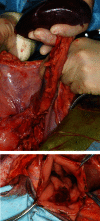Total pancreatectomy for recurrent intraductal papillary mucinous carcinoma in remnant pancreas of pancreaticoduodenectomy for intraductal papillary mucinous adenocarcinoma
- PMID: 23709152
- PMCID: PMC3670023
- DOI: 10.1136/bcr-2013-009856
Total pancreatectomy for recurrent intraductal papillary mucinous carcinoma in remnant pancreas of pancreaticoduodenectomy for intraductal papillary mucinous adenocarcinoma
Abstract
A 62-year-old man underwent pancreaticoduodenectomy (PD) for intraductal papillary mucinous carcinoma (IPMC) in 2006. No signs of adenocarcinoma at the resection margin were found by intraoperative pathological examination of frozen sections. The postoperative pathological diagnosis was invasive carcinoma derived from IPMC and moderately differentiated tubular adenocarcinoma. A blood analysis in 2011 showed serum (CA19-9) to be increased since the initial resection. Imaging test showed a recurrent tumour at the site of the pancreaticogastrostomy (PG) in the remnant pancreas. We conducted total remnant pancreatectomy for recurrent IPMC and partial gastrectomy. Because both lesions had a histopathological resemblance, the pathological diagnosis was recurrent invasive IPMC. Based on this experience, it is important to facilitate early detection by annual check-up. And also, we recommend PG as a reconstructive intervention in patients at high risk of IPMC recurrence in the remnant pancreas following PD as it is grossly visible on upper gastrointestinal endoscopy.
Figures







Similar articles
-
Advantage of pancreaticogastrostomy in detecting recurrent intraductal papillary mucinous carcinoma in the remnant pancreas: a case of successful re-resection after pancreaticoduodenectomy.J Surg Oncol. 2006 May 1;93(6):511-5. doi: 10.1002/jso.20387. J Surg Oncol. 2006. PMID: 16615155
-
[A case report of total remnant pancreatectomy for ductal carcinoma after distal pancreatectomy for invasive intraductal papillary mucinous carcinoma].Gan To Kagaku Ryoho. 2012 Nov;39(12):2140-2. Gan To Kagaku Ryoho. 2012. PMID: 23268003 Japanese.
-
A large multicenter study of recurrence after surgical resection of branch-duct intraductal papillary mucinous neoplasm of the pancreas.Minerva Gastroenterol Dietol. 2017 Mar;63(1):50-54. doi: 10.23736/S1121-421X.16.02341-2. Epub 2016 Nov 8. Minerva Gastroenterol Dietol. 2017. PMID: 27824244
-
Two cases of pancreatic colloid carcinoma with different pathogenesis: case report and review of the literature.Clin J Gastroenterol. 2022 Jun;15(3):649-661. doi: 10.1007/s12328-021-01573-6. Epub 2022 Jan 20. Clin J Gastroenterol. 2022. PMID: 35048322 Review.
-
High-risk lesions in the remnant pancreas: fate of the remnant pancreas after pancreatic resection for pancreatic cancer and intraductal papillary mucinous neoplasms.Surg Today. 2020 Aug;50(8):832-840. doi: 10.1007/s00595-019-01852-3. Epub 2019 Jul 25. Surg Today. 2020. PMID: 31346809 Review.
References
-
- Klöppel G, Lüttges J. WHO-classification 2000: exocrine pancreatic tumors. Verh Dtsch Ges Pathol 2001;2013:219–28 - PubMed
-
- Longnecker DS, Adler G, Hruban RH, et al. Intraductal papillary-mucinous neoplasms of the pancreas. In: Hamilton SA, Aaltonen LA, eds. World Health Organization classification ot tumours: pathology and genetics of tumours of the digestive system. Lyon (France): IARC Press; 2000:219.2013
-
- Tanaka M, Chari S, Adsay V, et al. International consensus guidelines for management of intraductal papillary mucinous neoplasms and mucinous cystic neoplasms of the pancreas. Pancreatology 2006;2013:17–32 - PubMed
-
- Tomimaru Y, Ishikawa O, Ohigashi H, et al. Advantage of pancreaticogastrostomy in detecting recurrent intraductal papillary mucinous carcinoma in the remnant pancreas: a case of successful re-resection after pancreaticoduodenectomy. J Surg Oncol 2006;2013:511–15 - PubMed
Publication types
MeSH terms
LinkOut - more resources
Full Text Sources
Other Literature Sources
Medical
